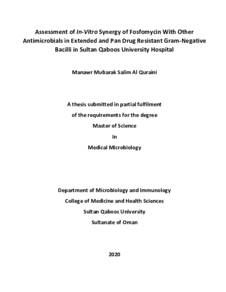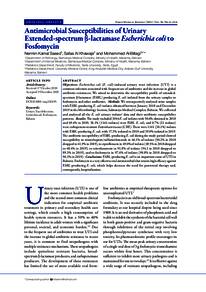Document
Assessment of in-vitro synergy of fosfomycin with other antimicrobials in extended and pan drug resistant GramNegative Bacilli in Sultan Qaboos University Hospital.
Publisher
Sultan Qaboos University.
Gregorian
2020
Language
English
English abstract
Overview: The rapid rise of microbial resistance to carbapenem (CR) and colistin
(CoR) in Gram-negative bacteria (GNB) is extremely alarming and presents an
unprecedented crisis in healthcare. As we inexorably inch towards the post-antibiotic
era, one has to make rational use of the available antibiotics like fosfomycin, colistin,
tigecycline, and carbapenems. Combination therapy in such situations provides an
effective alternative in the management of extremely drug-resistant (XDR) and pan
drug-resistant (PDR) bacterial infections. Understanding the interactions between
these antibiotics is essential to warrant successful treatment regimens. Objectives:
This study evaluated the in-vitro synergy of various combinations of fosfomycin (FOS)
with meropenem (MEM), colistin (CL), tigecycline (TGC), and amikacin (AK) against
XDR and PDR GNB using the checkerboard and time-kill assays. Colistin plus
meropenem was assessed in few representative bacterial isolates. Methods: Non
replicate XDR and PDR strains of K. pneumoniae (n=18), A. baumannii complex
(n=10), and P. aeruginosa (n=6) were studied. The phenotypic and genotypic
characterizations of the strains were done by BD Phoenix automated system and
Xpert Carba-R respectively. Minimal inhibitory concentrations (MICs) were
determined by agar dilution (AD) for fosfomycin and broth microdilution (BMD)
method for all other antibiotics including fosfomycin. All isolates were exposed to
combinations of two antibiotics in a checkerboard assay. Fractional inhibitory
concentration index (FICI) was used for interpreting the interactions between the
combined antibiotics. Time-kill assay (TKA) was performed for six representative
isolates to assess different combinations. Whole Genome Sequencing (WGS) was
carried out for the representative K. pneumoniae isolates (n=11). Results: Fosfomycin
resistance was identified in 62% and 23.5% of all isolates as per EUCAST and CLSI
respectively. Of the isolates, 97% and 100% were resistant to tigecycline and
meropenem respectively while 82% were susceptible to colistin. Amikacin was
sensitive in 83%, 28%, and 10% of P. aeruginosa, K. pneumoniae, and A. baumannii
respectively. Fifteen K. pneumoniae isolates harboured OXA-48-like, mostly OXA232, two were NDM-type, and one was NDM5+OXA232. Three sequence types were
identified by WGS: the majority were ST-231, followed by ST-395, and ST147.
Multiple resistance genes to β-lactams, aminoglycosides, and fosfomycin were
detected by WGS. Carbapenemases were not detected in any of A. baumannii
isolates whereas three P. aeruginosa isolates carried IMP1, one was VIM-type, and
not detected in two isolates. FOS-MEM was the most successful synergistic
combination for all isolates. FOS-AK was extremely active against K. pneumoniae
whereas CL-MEM was highly active in A. baumannii and P. aeruginosa with MEM MIC
of ≤32 mg/L, and least in K. pneumoniae. Antagonism was observed mostly against
V
FOS-TGC in 100% and 44% of K. pneumoniae, and A. baumannii respectively, and
against FOS-AK in all amikacin-susceptible isolates. FOS-CL demonstrated indifferent
interactions in all PDR isolates. Conclusions: Fosfomycin alone has excellent
bactericidal activity against all XDR and PDR isolates. FOS+MEM and FOS+AK
combinations hold therapeutic potentials for K. pneumoniae while FOS+MEM and
CL+MEM are promising combinations for A. baumannii and P. aeruginosa. FOS+CL
and FOS+TGC were least effective in all K. pneumoniae and A. baumannii.
Member of
Resource URL
Arabic abstract
تمثل مقاومةالميكروبات للمضادات الحيوية مصدر قلق متزايد وتهدد نظام الرعاية الصحية الذي يعتمد بشكل أساسي على المضادات الحيوية في العلاج المباشر للعدوى والجراحة الآمنة وطب الطوارئ. تطور وانتشار AMR هو ظاهرة طبيعية لا يمكن السيطرة عليها في الميكروبات. ان الطريقة التي نصنع بها ، واستخدامها والتخلص منها العوامل المضادة للميكروبات تسريع هذه العملية بشكل كبير. تم استخدام العلاج بالعقاقير المضادة للمضادات الحيوية في علاج الالتهابات السلبية الغرام في غياب خيارات أخرى. وبالتالي ، فإن تطوير مجموعات جديدة من المضادات الحيوية قد يساعد في تحسين نتائج المرضى من خلال تحقيق التأثير التآزري والتوقف عن اكتساب آليات مقاومة جديدة عن طريق الكائنات المقاومة للأدوية المتعدد
Category
Theses and Dissertations


